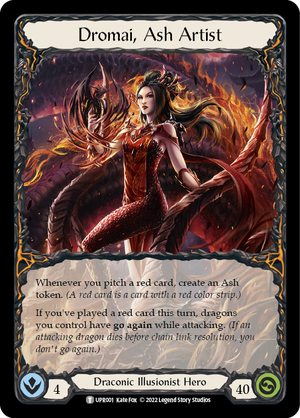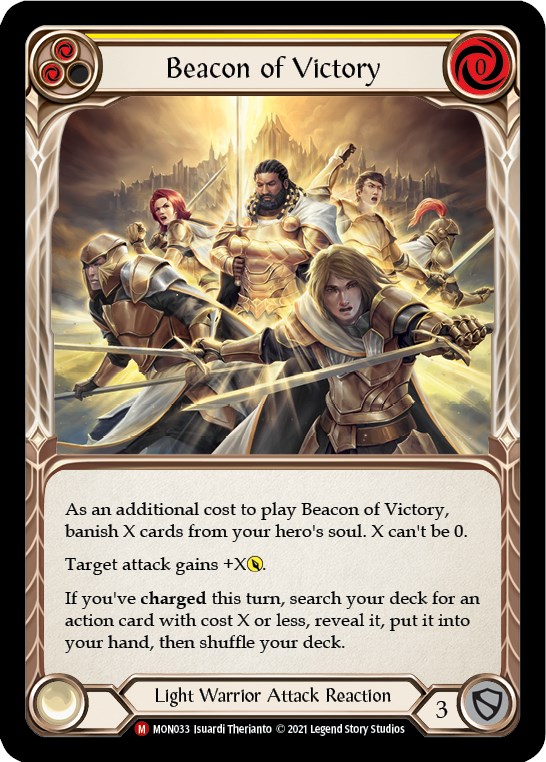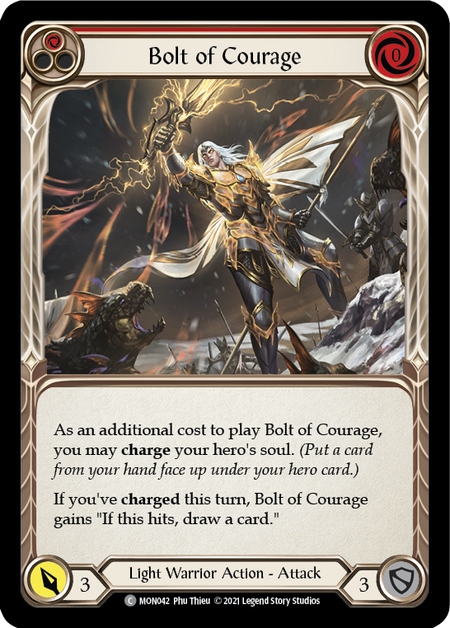Considering Charge: Exploring Alternative Resource Mechanics in Flesh and Blood
Share


Boltyn’s resource math is much simpler, or at least has fewer variables, than Dromais. Each card in his soul represents either one instance of Go Again (worth about 1.5 points of value), or one damage (from Beacon of Victory). This is the only alternative resource he can move from turn to turn, unlike Dromai who can move all of her resources across turns. Additionally, Boltyn’s ability to use multiple resources carried over from previous turns effectively is heavily limited. Dromai naturally carries over the value of each existing dragon, whereas Boltyn can only give each attack Go Again once per turn. Add in the requirement that one card go to Charging for the turn, and Boltyn’s options grow thinner.


With Dromai’s ash having a value of nearly two resources for each token, and dragons holding their combined attack and health value, Dromai has sticking power across turns. The buffs that Boltyn receives from having Charged in a single turn are generally restricted to the text on his cards (and therefore limited to what is in his hand at any time). The exception to this is his conditional power buff, which struggles to provide more than two points of value on a turn where it is active. His cards do become much more powerful after he has charged, threatening card draws, intense amounts of damage, or extreme resource efficiency.
![Lumina Ascension [U-MON034] Unlimited Normal | Red Riot Games CA](https://redriotgames.ca/cdn/shop/products/b357a196-3f70-59fa-8435-8366af5cad01_e0fa81a6-090d-43be-a7d8-d910f8568781.png?v=1631307344)
![Bolting Blade [U-MON032] Unlimited Normal | Red Riot Games CA](https://redriotgames.ca/cdn/shop/products/a1d6994f-fa60-5b4b-9e7a-5f5c7dfc42a6_aa843ae6-21c5-4811-b99e-61b8dc9925af.png?v=1631307343)
What this results in is an alternative resource system that ends up almost as binary options: Do I have a card to charge this turn, and if so, do I have enough soul to unlock the full text of the cards in this individual hand? The only saving grace of Boltyn having to operate within these limitations is Beacon of Victory’s ability to search for any card he would want. But even this power is still largely limited to a single turn. The addition of Bannerets has given some incidental value to Boltyn’s charging, making them a strong value proposition when things line up. However, the fact that he is limited so severely by not effectively carrying resources across turns, while those resources also cost a card from hand each turn, make it a challenge for him to be as consistently powerful as Dromai. With that said, he does have much more explosive potential, albeit exclusively through the use of Lumina Ascension and V of the Vanguard.
![V of the Vanguard [U-MON035] Unlimited Normal | Red Riot Games CA](https://redriotgames.ca/cdn/shop/products/004c4994-31ce-53e3-8c3b-a7513b073ada_829944e6-8f08-4b48-939c-1bbd944db7e3.png?v=1631307345)
![Banneret of Courage [DTD048] (Dusk Till Dawn) | Red Riot Games CA](https://redriotgames.ca/cdn/shop/products/afd66267-6d70-5368-b0c0-921d5fe8228e.png?v=1695863247)
![Banneret of Gallantry [DTD049] (Dusk Till Dawn) | Red Riot Games CA](https://redriotgames.ca/cdn/shop/products/249e72f9-b0da-5bdc-b1d3-2fcddf574cd1.png?v=1695863250)
Now that we have looked at the difference between Dromai and Boltyn’s resources, we can see the recurring theme that being able to move power across turns is much stronger, as it allows for repeated presentation of value. Consider a brief thought experiment: What if Dromai had to put a card from hand face down under each dragon she made (except Aether Ashwings), just like Boltyn has to do to charge? Let’s also assume that each dragon now has a reduced resource cost. The one-cost dragons, which are generally lauded as being “ash neutral” would make sense to cost zero in this scenario, as the red card you normally pitch to pay for them and generate the ash is now under our dragon. Putting a card under the dragon instead of ash leads to very similar outcomes within an individual turn. However, it makes it much harder for Dromai to set anything up or build a large board to snowball the game. She loses the ability to ever summon three dragons in a turn, and she would find herself fatiguing very quickly instead of pitching strong red cards to come up in a second deck cycle. She also loses the ability to stockpile Ash for back-to-back power turns.
![Aether Ashwing // Ash [UPR042/UPR043] (Uprising) | Red Riot Games CA](https://redriotgames.ca/cdn/shop/products/ab5d3f03-08fb-52c2-8e33-f6c47687845a_85dfa80b-b9a7-439e-aa5f-8f14cde16d8d.jpg?v=1658419247)
![Invoke Yendurai // Yendurai (Marvel) [UPR017] (Uprising) Cold Foil | Red Riot Games CA](https://redriotgames.ca/cdn/shop/products/32765279-71b8-520e-a986-62f5a2d4c078.png?v=1658419131)
The above scenario is worse for Dromai in nearly every way. In a lot of ways, this is what Boltyn has to deal with through his Charge and soul mechanics. Consider a corollary thought experiment where Boltyn adds a token card to his soul every time he pitches a yellow card. He begins to feel a lot more like Dromai, and he feels so much smoother. I think there is a “walk a mile in others’ shoes” lesson to be had here. Having played these modified heroes across my kitchen table, it shows how much impact small design changes can have.
As the above scenario highlights, the fact that Boltyn loses a card each and every turn stings and can hamper eventual payoff turns. While combo pieces and in-turn investments are very crucial for tide-shifting turns, you don’t want to make that investment every turn. Energy Potion is one of my favourite cards in this game, but I acknowledge that it is a very situational card that exists to solve specific problems and go over the top in certain matchups. But no one wants to play an Energy Potion each and every turn to power their deck’s engine. Sometimes that’s what Charging a card feels like, but it is almost never what pitching a card to make an Ash token feels like.
Because of the design-based nature of this alternative resource tension, I’m not sure that any amount of buffs to Boltyn (through Bannerets or other incremental means) will solve this issue. He can certainly become an insanely powerful hero through the Ranger treatment, by printing enough standalone power cards to overcome the weakness of his alternative resources. Give him Twomina Ascension, which can just be a fourth, fifth, and sixth copy of Lumina Ascension in his deck, he would become a very powerful hero.
![Raydn, Duskbane [MON031] 1st Edition Normal | Red Riot Games CA](https://redriotgames.ca/cdn/shop/products/26eef041-f8ae-5414-8f0f-ba7447e0345b.png?v=1631307679)
![Cintari Saber (Rainbow Foil) [CRU080-RF] Unlimited Rainbow Foil | Red Riot Games CA](https://redriotgames.ca/cdn/shop/products/ad2af100-c71f-5a6c-aba8-55407ae54dd8_0193ed53-9282-4ecb-8fb3-ae94cc9a17f2.png?v=1631227451)
Overall, I think that ash as an alternative resource is a much more elegant and flexible resource system than soul, and it is no surprise that Dromai is a more powerful hero than Boltyn because of this flexibility. I haven’t talked much about the design elements of ash against soul, but it is the multi-turn design, and token nature of ash that allows it to function so much more smoothly across a dynamic game, with a constantly evolving strategy, than soul can. Boltyn basically has to commit to his strategy when choosing which weapons he presents: a build-up to a one-turn killer combo with Cintari Sabres, or a continuously aggressive strategy with Raydn. From a rules perspective, there are some elements of ash that can be confusing or unintuitive for those without a judge certification. The main example of this is the creation of ash from Dromai’s ability being too late to use as a target for a dragon being made, but not too late to use to make an Ashwing from Rake the Embers. However, once a player understands this odd interaction, the smoothness of the ash mechanic returns and becomes a fun management puzzle throughout the game for Dromai players.
![Rake the Embers (Red) [UPR033] (Uprising) | Red Riot Games CA](https://redriotgames.ca/cdn/shop/products/655ff3f6-23e2-52a7-9774-e575c56aaad0_dc289b94-a062-449d-a220-455beabb9a70.png?v=1658419255)
![Invoke Themai // Themai (Marvel) [UPR015] (Uprising) Cold Foil | Red Riot Games CA](https://redriotgames.ca/cdn/shop/products/a2c79f38-9ab2-50ae-bc15-ba0a3e1c4abd.png?v=1658419156)
